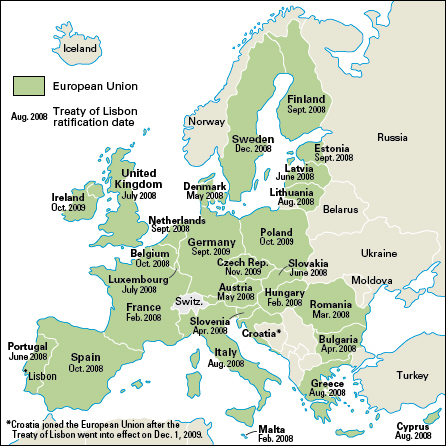Lisbon, Treaty of, is an amendment to a group of treaties that formed and organized the European Union (EU). The treaty, originally ratified in Lisbon, Portugal, went into effect on Dec. 1, 2009. It revised the 1992 Treaty on European Union, signed in Maastricht, the Netherlands, as well as the Treaty establishing the European Community, signed in its original form in 1957 in Rome. It has since been renamed the Treaty on the Functioning of the European Union. The Lisbon treaty improved EU cooperation on defense, security, and external policy. It also strengthened the role of the European Parliament and gave legal force to the Charter of Fundamental Rights for EU citizens. The ratification of the Lisbon treaty followed a period, from 2004 to 2007, in which 12 new nations joined the EU. These additions, along with other concerns, created the need for an amended constitutional agreement.

The chief goal of the Treaty of Lisbon was to create “a more democratic and transparent Europe.” The agreement reinforced the EU’s “four freedoms”—the free movement of goods, capital, services, and persons. It also strengthened legal and political protection for individual EU citizens.
The treaty strengthened the European Parliament while also increasing the involvement of national parliaments. In addition, it streamlined the EU’s working methods and voting rules. The Treaty of Lisbon increased the EU security network to counter threats from natural disaster, organized crime, and terrorism. According to the terms of the treaty, the president of the European Council and a new High Representative of the Union for Foreign Affairs and Security Policy were also granted more power to deal with the EU’s worldwide political partners. The Treaty of Lisbon includes an escape clause to the EU constitution that allows member states to withdraw from the union.
